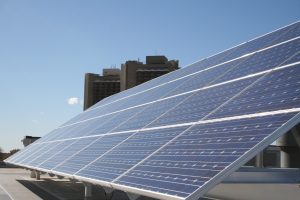Local groups offer sunny proposition to would-be solar users
Dave Fidlin — August 12, 2016

Solar panels on the outside Normal’s Children’s Discovery Museum. The more people see solar panels, the more interest will be sparked, says Larissa Armstrong of the Normal-based Ecology Action Center. (Photo courtesy Central Illinois Solar)
If Larissa Armstrong’s wish comes true, solar panels will soon adorn swaths of homes, businesses and other facilities across Bloomington, Normal and other communities within McLean County.
Armstrong, a staffer at the Normal-based Ecology Action Center, is among a group of organizers who has been instrumental in bringing a unique solar installation group-buy program to residents and business owners across the county.
The EAC is working in tandem with the Midwest Renewable Energy Association, based in Custer, Wis., through a comprehensive program, dubbed Solar Bloomington-Normal, which is designed to share information about the virtues of using solar energy.
“This is an outcrop of a successful program in the Champaign-Urbana area,” Armstrong said, pointing to the impetus of Solar Bloomington-Normal’s origins. “There has been some grant funding that has helped break down some of the barriers as we work hard to spread the word about this.”
From Armstrong’s vantage point, the time to choose solar power has never been better within McLean County. From now until late September, participants will have an opportunity to take part in the group-buy option, which Armstrong said reflects pricing that is about 15 to 20 percent below market rate prices.
Additionally, the federal government is offering a one-time 30-percent tax credit to participants, meaning a portion of the cost can be deducted the year the panels are installed.
The federal credit program, which is designed to encourage a rapid spike in the number of solar energy users across the U.S., was to have sunset at the end of this year. A bipartisan vote of support late last year, however, lengthened the program through the end of 2019.
The EAC and MREA embarked on what Armstrong described as a “robust” request for proposals process and selected a contractor — St. Louis-based Straight Up Solar — to handle the logistical aspects of the program, including the actual installation of the panels.
“We have a history of working in this region,” said Emma Gilmore, a project developer with Straight Up Solar. She pointed out the company operates a satellite office in Bloomington.
Straight Up Solar and the EAC have been hosting a series of aptly titled Solar Power Hours, which are information sessions designed to share the ins and outs of solar power.
In addition to a question-and-answer session, Straight Up Solar representatives are on hand to provide cost estimates to prospective users at each of the sessions.
While there are a number of variables in the equation, Straight Up Solar has provided an estimate for an average home using 5 kilowatts of traditional energy. With the group-buy scenario and tax incentives factored in, the cost of a home using this level of consumption would hover around $5,250.
“For homeowners, the payoff is usually within seven years,” Armstrong said. “The solar panels are at their peak performance for 25 years, although they last longer than that. It’s really a great long-term investment, financially.”

Crews install solar panels on a McLean County home. The Normal-based Ecology Action Center is working to spread information about the long-term benefits of solar power for residents.
(Photo courtesy Grow Solar Midwest)
Gilmore said participants have raised a number of recurring questions at the Solar Power Hour sessions that have already taken place. One frequently asked query points to Central Illinois’ unpredictable weather.
“I’ve heard from people who have asked about the solar power glass, and how it will withstand hail,” Gilmore said. “(Solar panels) are made of temperate glass, and they’re designed to withstand 50-mile (per hour) winds and 1-inch hailstones.”
In extreme weather situations, Gilmore said property owners’ insurance policies typically cover damage to solar panels.
One final Solar Power Hour information session is scheduled on Tuesday, Aug. 9, though Armstrong said an additional meeting or two could be added in late August or September to coincide with the resumption of school.
Straight Up Solar made its first official installation through the Solar Bloomington-Normal program in mid-July. By the end of the month, Armstrong said about 170 property owners across the county were at least considering installing solar panels.
“Once someone starts to do it, it becomes a conversation piece, and it will spread,” Armstrong said. “I’m excited to be a part of this. I think it has a lot of potential.”
AT A GLANCE
WHO: Representatives from Straight Up Solar, Ecology Action Center
WHAT: Solar Power Hour information session on benefits, logistics and costs of installing solar panels
WHEN: 6 p.m. Tuesday, Aug. 9
WHERE: Bloomington Public Library, 205 E. Olive St.
INFORMATION: www.solarbloomingtonnormal.com
— Local groups offer sunny proposition to would-be solar users —



